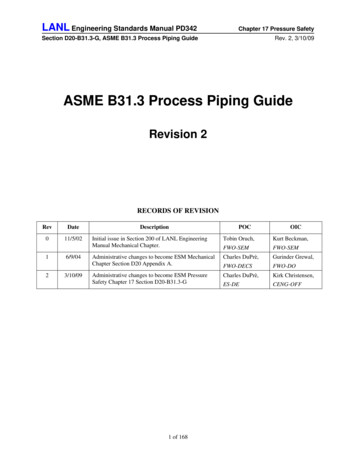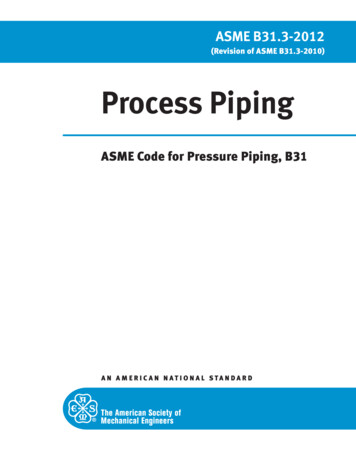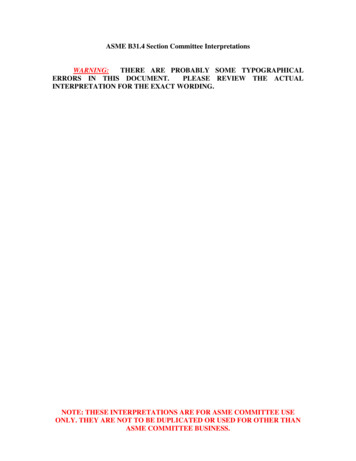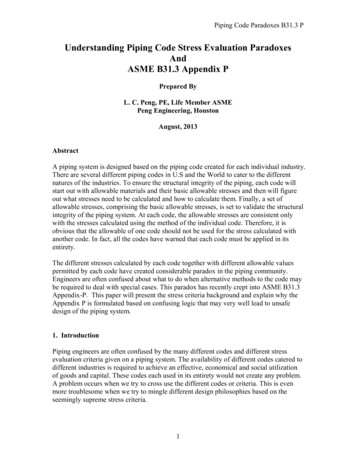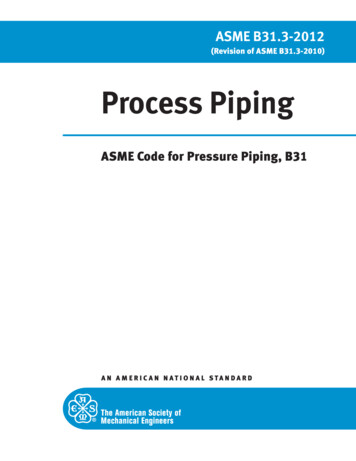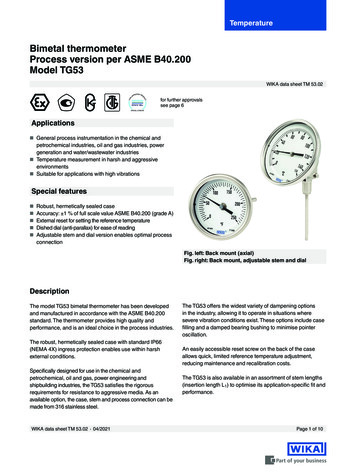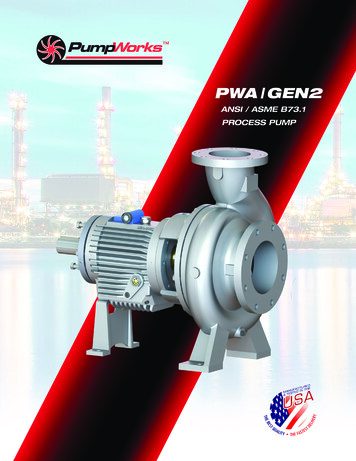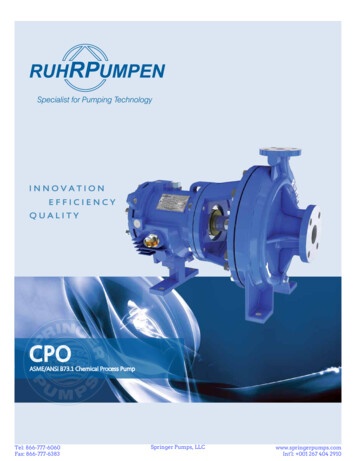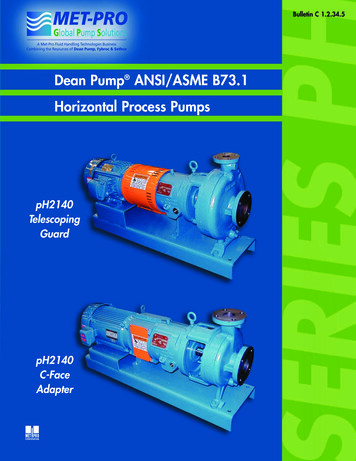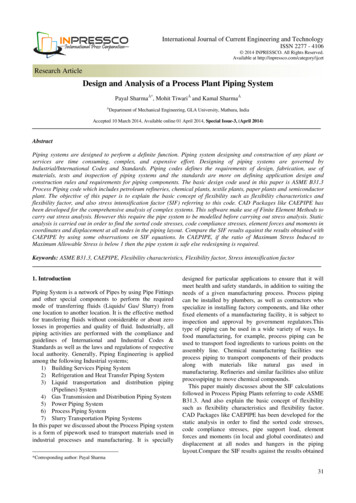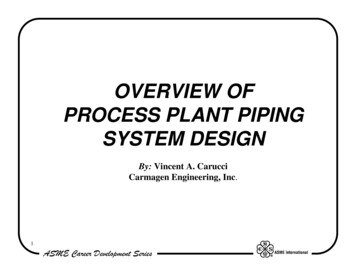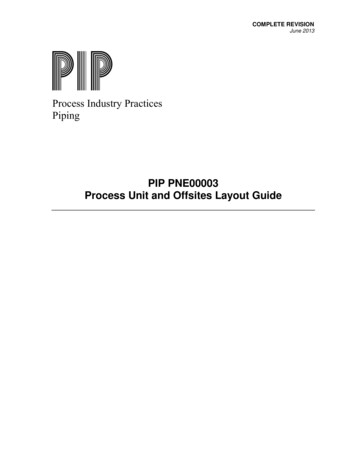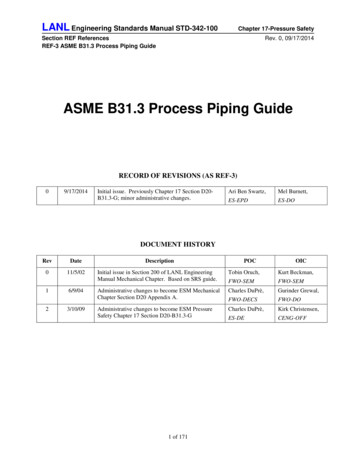
Transcription
LANL Engineering Standards Manual STD-342-100Chapter 17-Pressure SafetySection REF ReferencesREF-3 ASME B31.3 Process Piping GuideRev. 0, 09/17/2014ASME B31.3 Process Piping GuideRECORD OF REVISIONS (AS REF-3)09/17/2014Initial issue. Previously Chapter 17 Section D20B31.3-G; minor administrative changes.Ari Ben Swartz,Mel Burnett,ES-EPDES-DODOCUMENT COICInitial issue in Section 200 of LANL EngineeringManual Mechanical Chapter. Based on SRS guide.Tobin Oruch,Kurt Beckman,FWO-SEMFWO-SEMAdministrative changes to become ESM MechanicalChapter Section D20 Appendix A.Charles DuPrè,Gurinder Grewal,FWO-DECSFWO-DOCharles DuPrè,Kirk Christensen,ES-DECENG-OFFAdministrative changes to become ESM PressureSafety Chapter 17 Section D20-B31.3-G1 of 171
LANL Engineering Standards Manual STD-342-100Section REF ReferencesREF-3 ASME B31.3 Process Piping GuideChapter 17-Pressure SafetyRev. 0, 9/17/2014TABLE OF CONTENTSPURPOSE .4B31.3 INTRODUCTION .4I - SCOPE AND DEFINITIONS .5II - DESIGN .6III - MATERIALS . 16IV -STANDARDS FOR PIPING COMPONENTS . 16V - FABRICATION, ASSEMBLY AND ERECTION . 16VI - INSPECTION, EXAMINATION AND TESTING . 21APPENDIX A – PIPING SPECIFICATIONS . 26APPENDIX B – FLUID SERVICE SHEETS . 80APPENDIX C – MATERIALS SELECTION . 101APPENDIX D – VALVE SELECTION GUIDE . 106APPENDIX E – FLANGED CONNECTIONS . 119APPENDIX F – ALIGNMENT FIT-UP TOLERANCES . 127APPENDIX G – COMPONENT IDENTIFICATION . 132APPENDIX H – LEAK/PRESSURE TESTING . 140APPENDIX I – STRESS ANALYSIS . 145APPENDIX J – FILLET WELD SIZES. 151APPENDIX K – CLEANING CARBON AND STAINLESS STEEL PIPE. 156APPENDIX L – BURIED PROCESS PIPE . 162APPENDIX M – MITERED JOINTS . 163APPENDIX N – BRANCH CONNECTIONS . 165APPENDIX O - SAFETY CLASS PIPING SYSTEMS . 167APPENDIX P – REPAIRS, MODIFICATIONS AND MAINTENANCE . 168APPENDIX Q - APPLICATION OF ASME B31.3 TO RADIOACTIVE FLUIDS . 170Page 3 of 171
LANL Engineering Standards Manual STD-342-100Chapter 17-Pressure SafetySection REF ReferencesREF-3 ASME B31.3 Process Piping GuideRev. 0, 9/17/2014APPENDIX R – DEFINITION OF ACRONYMS . 171PURPOSEThis Guide provides information for the proper application of the ASME B31.3 Code "Process Piping,” Itwas last updated for the 2002 edition. ASME B31.3 applies to process piping and tubing systems at LosAlamos National Laboratory (LANL). This Guide also contains ASME B31.1 and AWWA compliant PipingSpecifications. Guide users are responsible for compliance with all aspects of the applicable Code. ThisGuide addresses only B31.3, however this guidance is typical of the requirements of other piping Codes.The information contained in this Guide provides clarification to the Code text, additional information notcontained in ASME B31.3, and design input specific to LANL. This Guide is not to be used as a standalone document. This Guide is formatted to be used in conjunction with ASME B31.3, by following thesame section numbering as B31.3 Code. Appendix references herein are to this Guide, not B31.3 or theESM, unless otherwise noted.A user who desires clarifications on the application of piping related Codes and Standards should contactthe LANL Engineering Standards Pressure Safety Point-of-Contact.In the event of a contradiction between this and other ESM material, the other material shall have priority.B31.3 INTRODUCTIONThe Introduction to ASME B31.3 states "It is the owner's [Design Authority] responsibility to determinewhich Code Section is most applicable to the piping installation.”The other ASME B31 Code Sections and other common National Consensus Codes are listed in Table 1.Building and plumbing Codes as required by state and local jurisdictional requirements apply to potablewater, and for sewer and drain systems that do not have a process function.Table 1- National Consensus Codes and Standards for .4B31.5B31.8B31.9B31.11Z223.1C 100C 200C 300C 400C 500C 600C 900M9M11MultipleTitlePower PipingLiquid Petroleum Transportation Piping SystemsRefrigeration PipingGas Transmission and Distribution Piping SystemsBuilding Services PipingSlurry Transportation Piping SystemsNational Fuel Gas Code (same as NFPA 54)Cast-Iron Pipe, FittingsSteel PipeConcrete PipeAsbestos Cement PipeValves and HydrantsPipe LayingPVC Pressure PipeConcrete Pressure PipeSteel Pipe-Guide for Design and InstallationFire Protection SystemsGuidance supplementing the Code is necessary because the Code provides no explicit rules forfunctional design, material compatibility with fluid and environment (erosion/corrosion protection, radiationPage 4 of 171
LANL Engineering Standards Manual STD-342-100Section REF ReferencesREF-3 ASME B31.3 Process Piping GuideChapter 17-Pressure SafetyRev. 0, 9/17/2014effects, etc.), layout, serviceability, steam tracing, grounding, valve and component selections, design ofpipe supports, material traceability, gasket selection, as-built tolerances, insulation, cleaning for specialprocess, etc. Also, for certain services some options available through B31.3 must be excluded, mademore stringent or supplemented by the designer.Warning: The original and continued safe operation of a piping system depends on the competentapplication of codes and standards.The Owner and Designer are responsible for compliance with the personnel and process qualificationrequirements of the codes and standards.In particular, the application of ASME B31.3 requires compliance with the Inspector qualificationrequirements of ASME B31.3 Section VI for all fluid services (safety or non-safety related).I - SCOPE AND DEFINITIONS300(b) -ResponsibilitiesThe following responsibilities are applicable at LANL:1)Owner - The Owner is the Design Authority. See Acronyms and Definitionssections in ESM Chapter 1 Section Z10 and Chapter 17, Pressure Safety.2)Designer - The Designer is the Design Agency.3)One of the signoffs on a piping work package must reflect an "Owner'sInspector" review. This means:The person signing must have the minimum experience of 340.4(b), andThe person signing must have verified, to the extent necessary, that code andengineering design requirements for examination and testing are met (341.4.1).300(c) -300.1.1 -300.1.3 -Intent of the Code1)The code addresses the structural integrity of the piping system. The designer isresponsible for all other aspects of the design including the functional design of thesystem.2)Recommendations for applying ASME B31.3 Code to repairs, modifications, andmaintenance are provided in Appendix P.3)Appendix B provides Fluid Service Sheets to assist in selection of materials forcompatibility with common fluid services. Historical TA-55 Specification 4401-J-1contains material recommendations for PF-4.Content and Coverage1)ASME B31.3 may be applied to Radioactive Fluid Services. See Appendix Q.2)Transfer lines between facilities (such as waste or steam transfer lines) thatsupport processing functions may be designed and constructed to ASME B31.3.Exclusions1)Note that paragraph 300.1.3 (a) does not exclude vacuum systems.Page 5 of 171
LANL Engineering Standards Manual STD-342-100Chapter 17-Pressure SafetySection REF ReferencesREF-3 ASME B31.3 Process Piping Guide300.2 -Rev. 0, 9/17/20142)Radioactive fluids should not be excluded from ASME B31.3 Scope.Appendix Q.3)For fire protection, refer to the NFPA Codes and ESM Chapter 2.SeeDefinitions1)Category M Fluid Service is recommended for safety class piping systems. SeeAppendix O.2)Radioactive fluids should not be classified as Category D Fluid Service.Appendix Q.3)The Owner’s Inspector is responsible for verifying the piping installation to theextent necessary to be satisfied that it conforms to all applicable examinationrequirements of the Code and of the Engineering Design. LANL Owner’sInspector(s) are designated by the Construction Engineering4)Normal fluid service Piping Specifications (Appendix A) may be used in CategoryD fluid service.5)Examiner - The person(s) certified by the employer as qualified to perform thequality control functions specified in ASME B31.3. The LANL ESM Chapter 13specifies how NDE is processed at LANL.SeeII – DESIGN301.1 -GeneralOf all the design considerations listed in 301, only pressure rating is covered in the PipingSpecifications in Appendix A. The Piping Specifications provide materials, fittings, andfasteners, which meet the pressure design requirements of B31.3. The designer mustaddress all design conditions.301.2.2 -Required Pressure Containment or ReliefPiping systems are designed to either safely contain or relieve the maximum pressurethat can be imposed. Plant fires can present a safety concern for certain piping systems.The installation of pressure relief devices should be considered for liquid systems greaterthan 6” ID that can have isolated fluid.Helpful information is available in ESM Chapter 17.301.5.1 -ImpactPiping systems must be designed to withstand anticipated fluid transients(waterhammers, pressure surges, etc.). These are the transients expected to occurduring normal operation of the system. Piping systems cannot be designed forunanticipated transients. These are the transients that can occur if the system is notproperly operated. Unanticipated transients must be eliminated by design (layout) andappropriate startup and operating procedures.Page 6 of 171
LANL Engineering Standards Manual STD-342-100Chapter 17-Pressure SafetySection REF ReferencesREF-3 ASME B31.3 Process Piping Guide301.5.2/3-Rev. 0, 9/17/2014Wind and EarthquakeThe applicable wind and earthquake requirements are defined LANL EngineeringStandards Manual Structural Chapter 5.301.5.4 -VibrationNew designs, modifications, repairs, replacements, should be visually inspected atstartup to verify that vibration is not excessive. The rules of ASME "Standards andGuides for Operation and Maintenance of Nuclear Power Plants" OM-S/G, Part 3, can beused for guidance. The ASME OM document provides a methodology to evaluatevibration using high cycle fatigue analysis and can be applied to any piping system.301.8 -Effects of Support, Anchor, and Terminal MovementsSoil settlement can adversely affect the integrity of a piping system and the flow in asloped line. When proper slope is required to maintain flow in an underground pipingsystem, soil settlements need to be evaluated in the design of the piping system.302.2.1 -Listed Components Having Established RatingsTables 326.1, A326.1, and K326.1 provide a listing of standards and specifications thathave been accepted by the Code. Some of these standards provide establishedpressure/temperature ratings for components (e.g., ASME B16.5). The components maybe used in piping systems within the specified ratings without additional analysis. If thesecomponents are used outside established ratings additional analysis is required.302.2.2-Listed Components Not Having Specific RatingsSome standards and specifications provided in Tables 326.1, A326.1, and K326.1 basepressure/temperature ratings on equivalent schedule (wall thickness) of straightseamless piping less mill tolerance (e.g., ASME B16.11). The ratings of thesecomponents are addressed in the piping specifications provided in Appendix A. If thesecomponents are used outside the limits e
2) Recommendations for applying ASME B31.3 Code to repairs, modifications, and maintenance are provided in Appendix P. 3) Appendix B provides Fluid Service Sheets to assist in selection of materials for compatibility with common fluid services. Historical TA-55 Specification 4401J-1 - contains material recommendations for PF-4. 300.1.1 - Content and Coverage ; 1) ASME B31.3 may be applied to .
